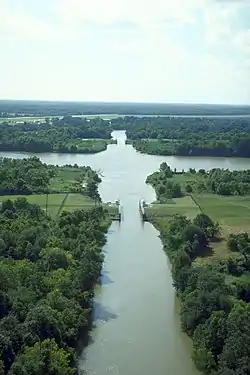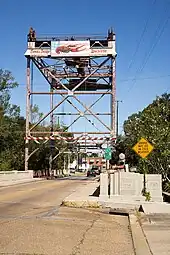Bayou Teche
Bayou Teche (Louisiana French: Bayou Têche) is a 125-mile-long (201 km)[1] waterway in south central Louisiana in the United States. Bayou Teche was the Mississippi River's main course when it developed a delta about 2,800 to 4,500 years ago. Through a natural process known as deltaic switching, the river's deposits of silt and sediment cause the Mississippi to change its course every thousand years or so.

History
The Teche begins in Port Barre where it draws water from Bayou Courtableau and then flows southward to meet the Lower Atchafalaya River at Patterson. During the 18th-century Acadian migration to the area - then known as the Attakapas region - the Teche was the primary means of transportation.[2]

The second engagement occurred on 14 January 1863. Union general Godfrey Weitzel learned that the J. A. Cotton was planning an attack on Weitzel's forces at Berwick Bay, Louisiana. Once again Kinsman, Calhoun, Estrella and Diana steamed into the Bayou, followed by Union transports. The bayou had been obstructed with debris. The Union gunboats and land-based units engaged the J. A. Cotton and Confederate infantry in rifle pits. During the battle Kinsman hit a mine and unshipped her rudder; the J. A. Cotton was badly damaged, and her crew set her on fire during the night to prevent capture.[3] The Union, however, was unable to hold the Teche, necessitating two more invasions of the Teche country in 1863 and 1864.
After the levees were built along the Atachafalaya River in the 1930s, the Teche and the rice farms located along the bayou suffered a drastic reduction in fresh water. Between 1976 and 1982, the United States Army Corps of Engineers built a pumping station at Krotz Springs to pump water from the Atchafalaya River into Bayou Courtableau.
The etymology of the name "Teche" is uncertain. One hypothesis is that it comes from "tenche", a Chitimacha Indian word meaning "snake", related to the bayou's twists and turns resembling a snake's movement. The Chitimacha tell an ancient story of how the snake attacked their villages, and it took many warriors many years to kill it. Where the huge carcass lay and decomposed, the depression it left behind filled with water to become the bayou.[4] Alternatively, George R. Stewart asserts that it is "probably a French rendering of Deutsch, the name by which the German colonists of the area would have named their stream. Cf. Allemand ['German']."[5]


Towns on Bayou Teche
Towns along the Teche include:
See also
- Bayou Teche National Wildlife Refuge
- Louisiana Swamps
- Bo Ackal, namesake of bridge over Bayou Teche on Lewis Street in Iberia Parish
- Bret Allain, sugar cane farmer and state senator from St. Mary Parish was reared on Bayou Teche.
References
- U.S. Geological Survey. National Hydrography Dataset high-resolution flowline data. The National Map Archived 2012-03-29 at the Wayback Machine, accessed June 20, 2011
- Campbell, R. Thomas (2008). Voices of the Confederate Navy: Articles, Letters, Reports, and Reminiscences. McFarland. p. 139. ISBN 9780786431489. Retrieved 26 July 2017.
- Rains, Gabriel J.; Michie, Peter S. (2011). Confederate Torpedoes: Two Illustrated 19th Century Works with New Appendices and Photographs. McFarland. p. 142. ISBN 9780786485451. Retrieved 27 July 2017.
- Louisiana Department of Culture, Recreation and Tourism. "Bayou Teche Historical Marker".
- George R. Stewart American Place-names (New York: Oxford University Press, 1970), p. 475.